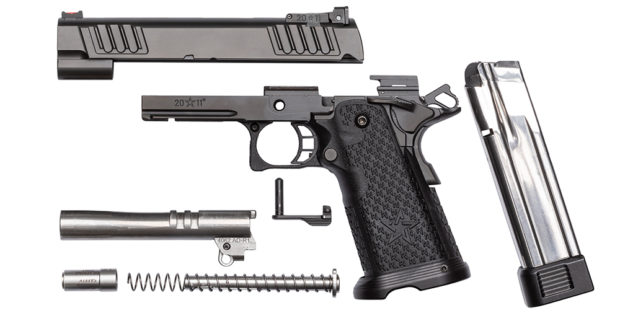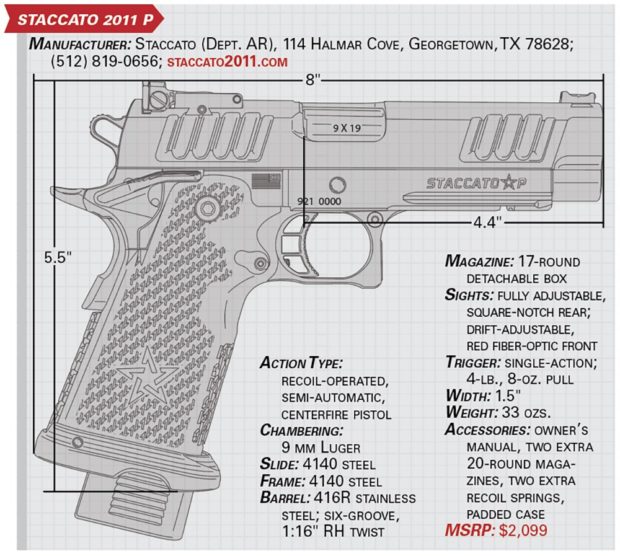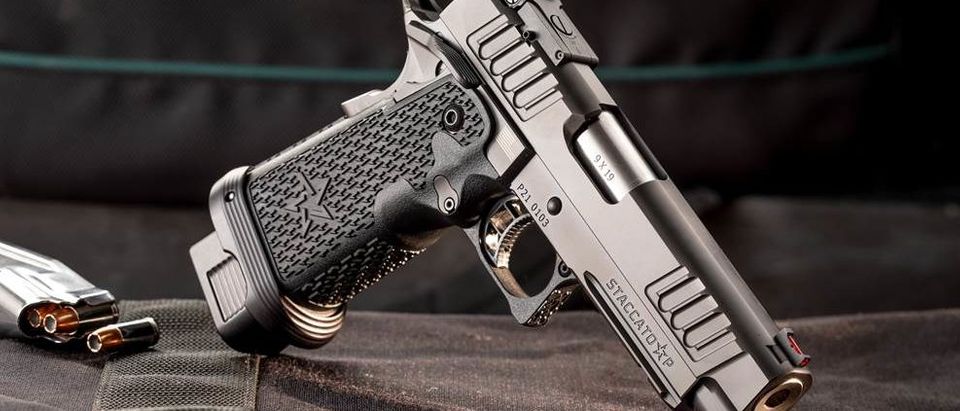The M1911 is now well into its second century of production with no sign of Americans dethroning it as one of the pre-eminent pistols for action-shooting competition. Though many features have been contemporized, the M1911’s essential elements—its grip angle, thumb and grip safeties and sliding, single-action trigger—still stand testament to the enduring worth of John Browning’s most prolific design.
The Staccato 2011 P tested here is one of five M1911-style models made by Texas-based Staccato, the successor to STI International. STI carved a niche in the M1911 competition market by developing designs compatible with double-stack magazines, but the company re-branded itself in 2020 and shifted its approach from marketing to the competition crowd to focusing on home defenders who primarily value reliability and accuracy.
While STI built M1911s using the traditional custom-house method where skilled gunsmiths create an accurate pistol by filing and grinding oversized parts to fit, Staccato, in contrast, relies on CNC machines to produce parts with tight tolerances. This allows the company to deliver a pistol that’s still capable of exceptional accuracy while reducing the need for hand-fitting—some is still necessary, but it is much reduced.
The Staccato 2011 P is chambered in 9 mm Luger and holds 17 rounds within its standard-capacity magazine and 20 rounds within an extended box. The pistol is 8″ long, 5.5″ tall and weighs 33 ozs. with an empty magazine. It is constructed with the serial-numbered steel frame joined to a one-piece, molded-polymer grip assembly. Three grip styles are available that differ with respect to their textures and sizes. Changing the grip is a factory operation, however, as correct seating of the trigger bow and sear spring are necessary to prevent doubling.

–
Steel parts are made from billets or bar stock, not castings or metal-injection molding. The frame and slide are machined from 4140 steel, with the slide pre-hardened. The 4.4″ barrel is made from 416R stainless steel, with an 11-degree target crown on the muzzle. An internal extractor is used, and the pistol does not employ a firing-pin capture device, which many shooters feel detracts from the M1911’s characteristically crisp trigger.
Most steel parts are diamond-like-carbon (DLC) finished for reduced friction and increased abrasion resistance. The slide has wide, forward-angled grasping grooves cut into both its front and rear, and the dustcover has a one-slot accessory rail. Two 20-round magazines and one 17-rounder are included with the gun; the polished, stainless-steel magazines have aluminum floorplates and witness holes along their rear surfaces.

The Staccato P uses a bushingless barrel, and the pistol’s Dawson 4.4 Adaptive Tool-less Recoil System features a full-length, stainless-steel guide rod with a pivoting section that captures the recoil spring and a reverse plug to simplify disassembly compared to the M1911’s traditional barrel bushing and recoil-spring plug. The front of the gently flared bull barrel mates directly with the slide to affect a consistent, tight fit when in battery, while lockup at the rear is accomplished using the M1911’s traditional swinging link and barrel lugs that lock the barrel into the slide. Two extra recoil springs are included, should the user wish to shoot particularly heavy or light loads.
The bilateral thumb safeties are well-fitted and activate with an ideal amount of tension, while the grip safety has a memory bump to make deactivation more positive and a beavertail just long enough to prevent hammer bite—yet not so long as to snag on clothing. The magazine-release button is small and, curiously, untextured. The skeletonized trigger shoe is polymer, with a textured face and an Allen setscrew to adjust overtravel. Our sample’s pull weight averaged 4 lbs., 8 ozs., with minimal travel during the break and no overtravel.
The grip is distinctively textured on all three sides and on the front of the trigger guard, but is smooth under the trigger guard where the shooter’s middle finger rests when grasping the pistol. An aluminum Dawson Precision Tactical Advantage Magwell is pinned to the base of the grip frame to ease reloading when the shooter is on the move or in darkness.
The Staccato P uses dovetailed steel sights consisting of a red fiber-optic front and a square-notch rear. The rear sight blade has glare-reducing horizontal serrations, and the top outer edges are bevel-cut with smoothed edges to prevent snagging on clothing or cutting your hand during slide manipulations. Each click of the fully adjustable rear sight moves the point of impact 0.67″ at 25 yards; it has a minor cocking ledge if necessity calls for racking the slide one-handed.
The Staccato proved to be superbly accurate, scoring mean 25-yard rested groups under 1.75″ with three test loads. The sights are intended for defensive shooting and are easy to acquire, align and recover after recoil, however, we believe even tighter groups would be achievable if the shooter were to switch to target sights that minimize alignment errors.

There were no stoppages during a 250-round firing session using the accuracy-testing loads and two other hollow-point rounds. One shooter appreciated the grip safety disengaging before its maximum travel, which allowed him to use his preferred grip that fails to disengage the safety on some M1911s. The Staccato’s trigger has some degree of take-up, which we feel is beneficial for a defensive pistol and could even be longer without becoming a hindrance. The slide serrations were ideal, with prominent edges that afford positive purchase without the need to apply a tight grip to cycle the action.
The Staccato 2011 P would be improved with a smaller grip than the version now used, which is large enough to accommodate .45 ACP magazines. A 9 mm-sized grip would allow shooters to access the magazine release without adjusting their grasp and to wear gloves without a sensation of grasping a pistol with substantial girth. But, overall, the pistol performs well and overshadows many M1911s with its accuracy, easier takedown and higher capacity.



